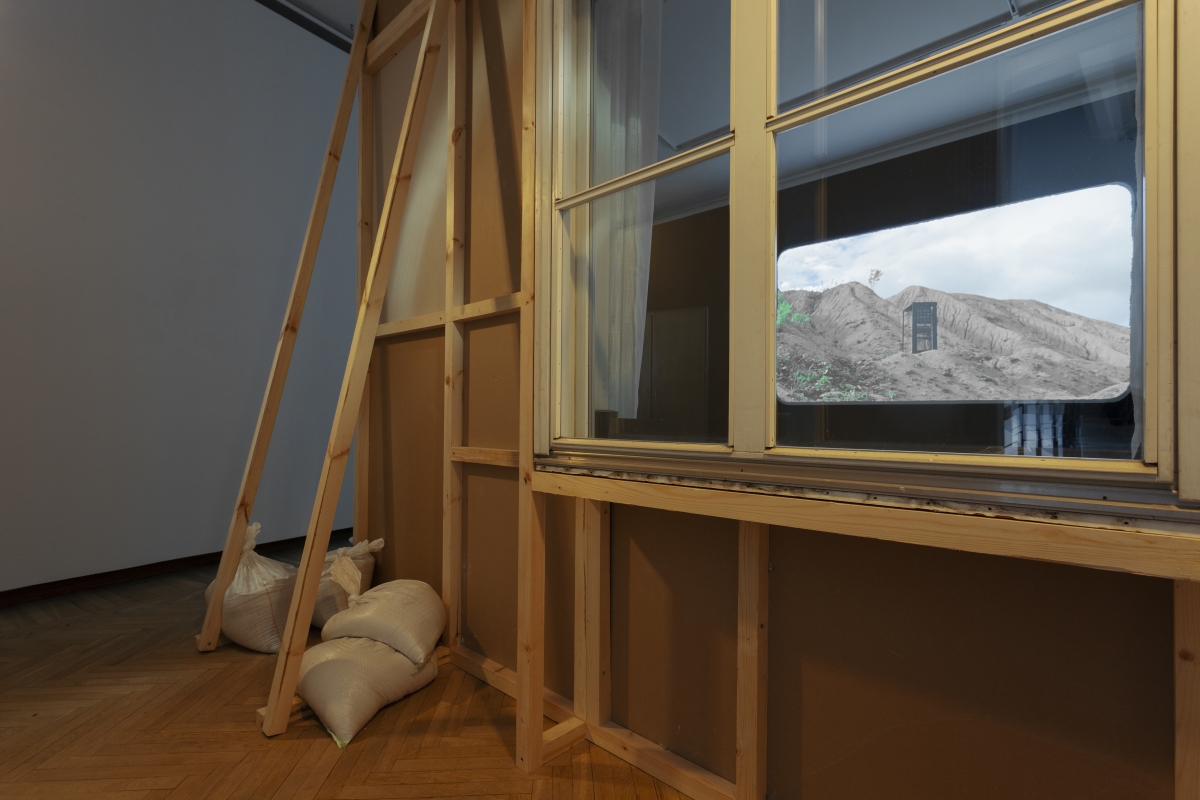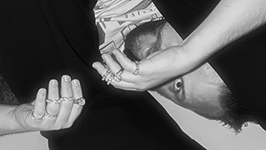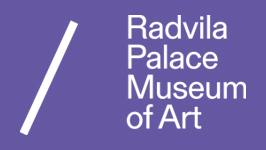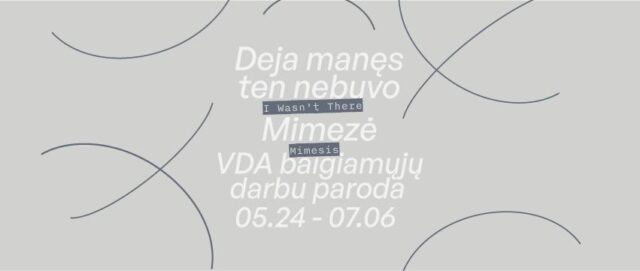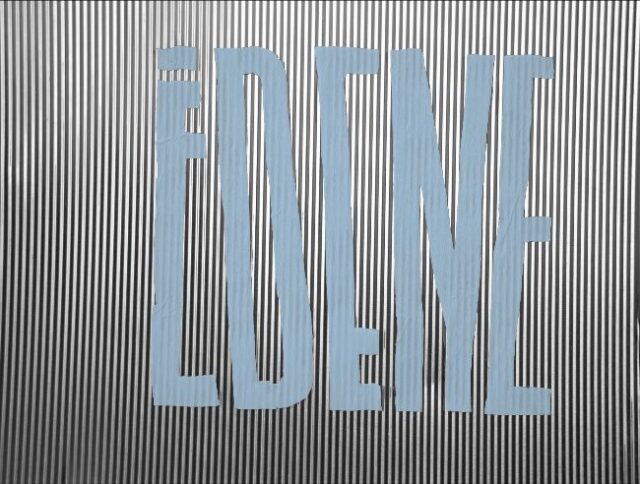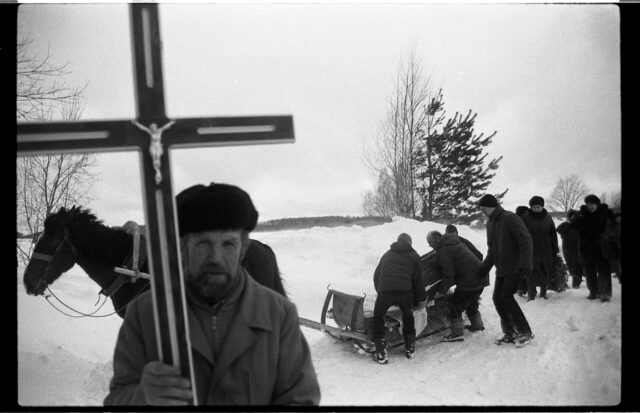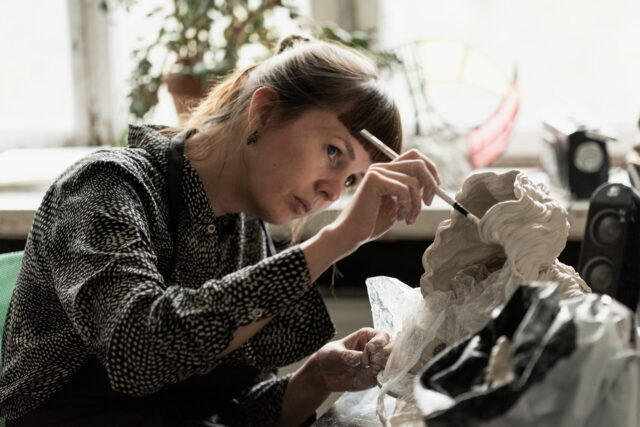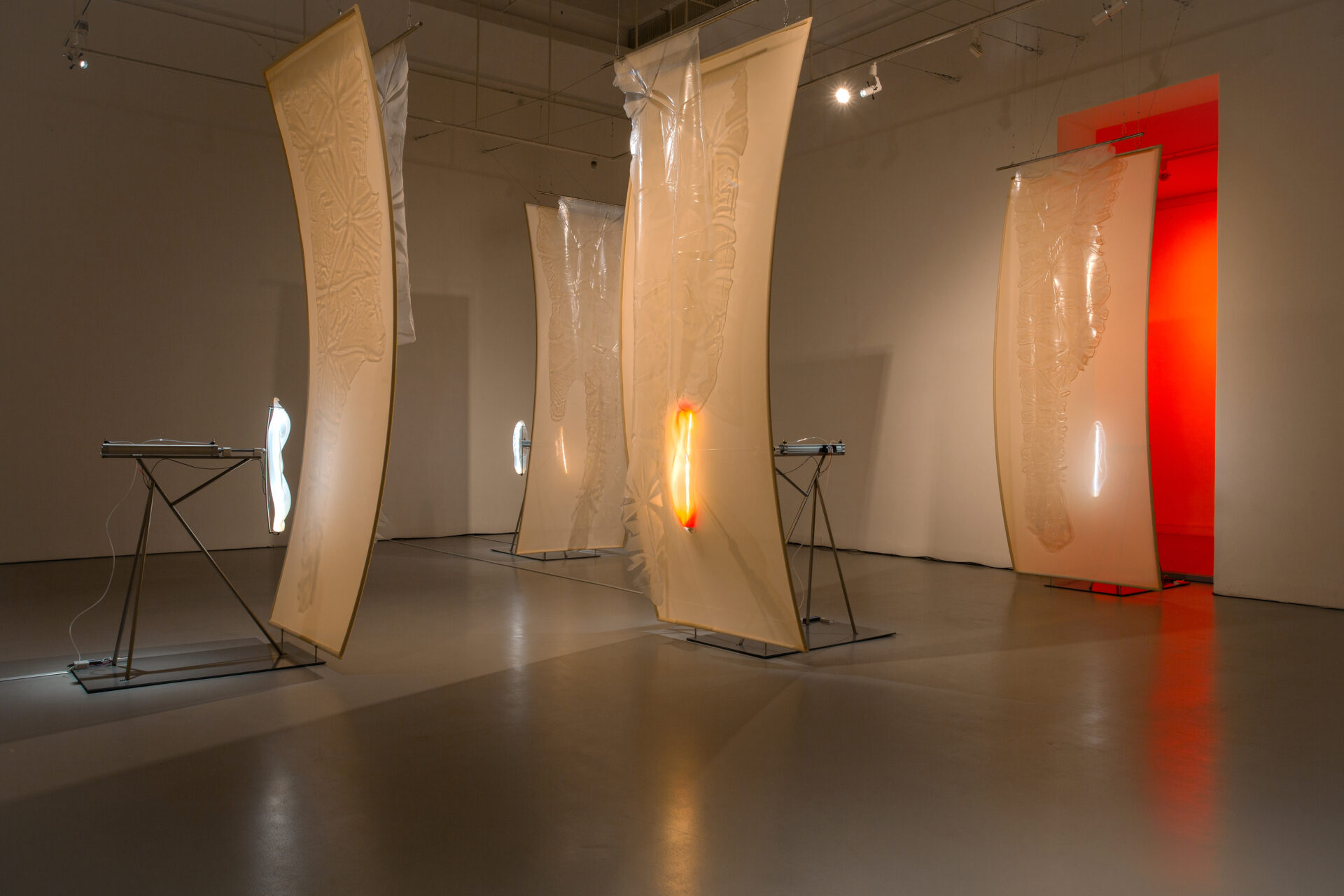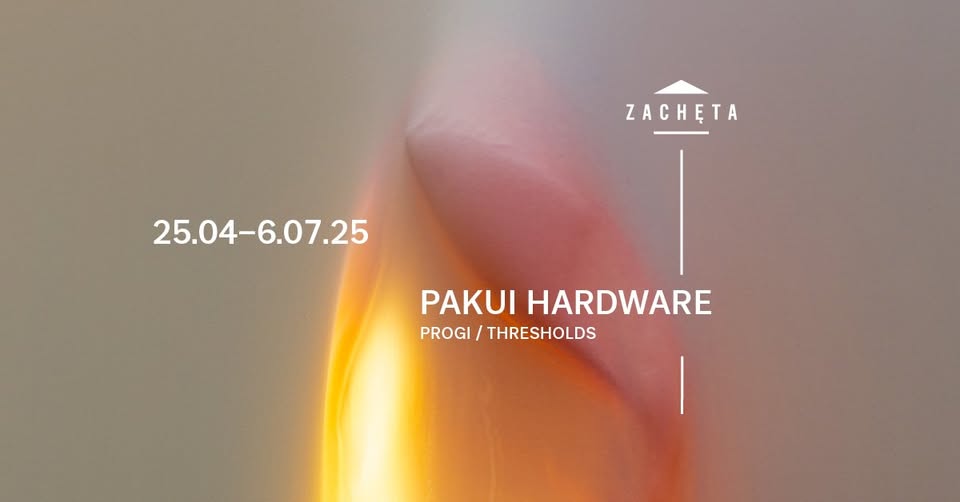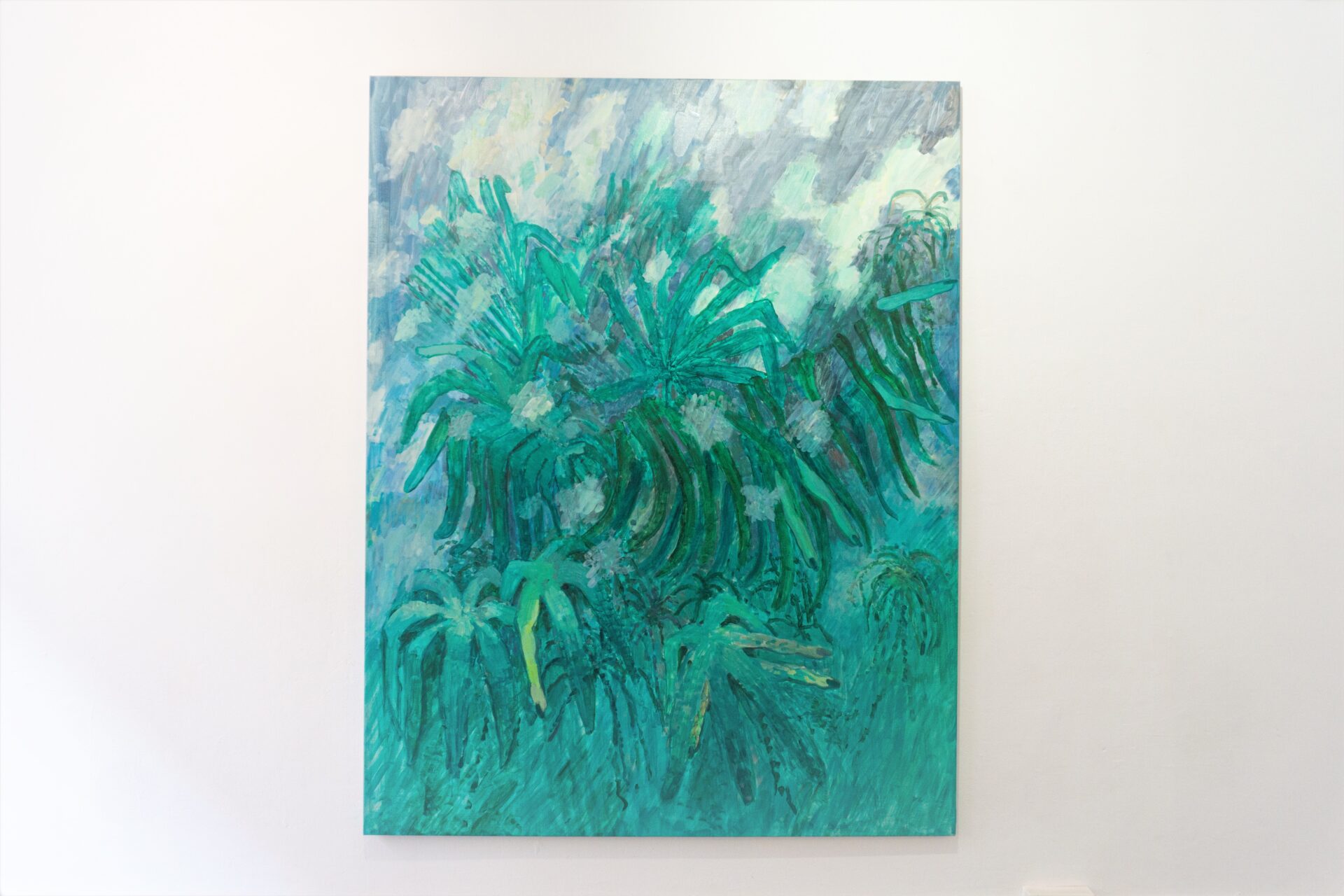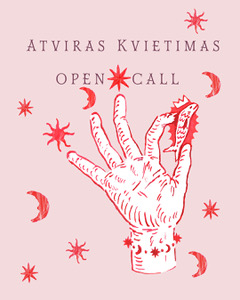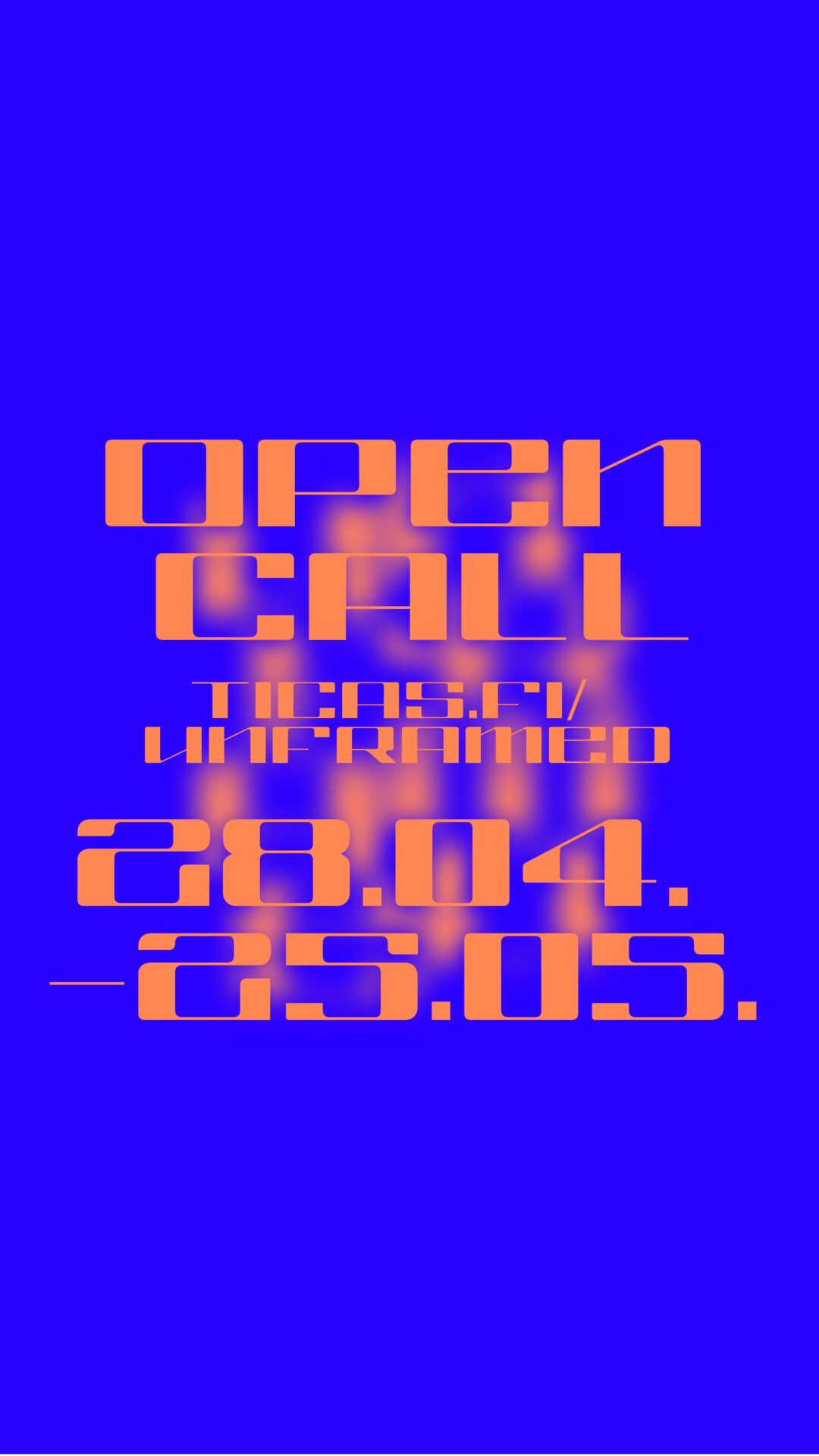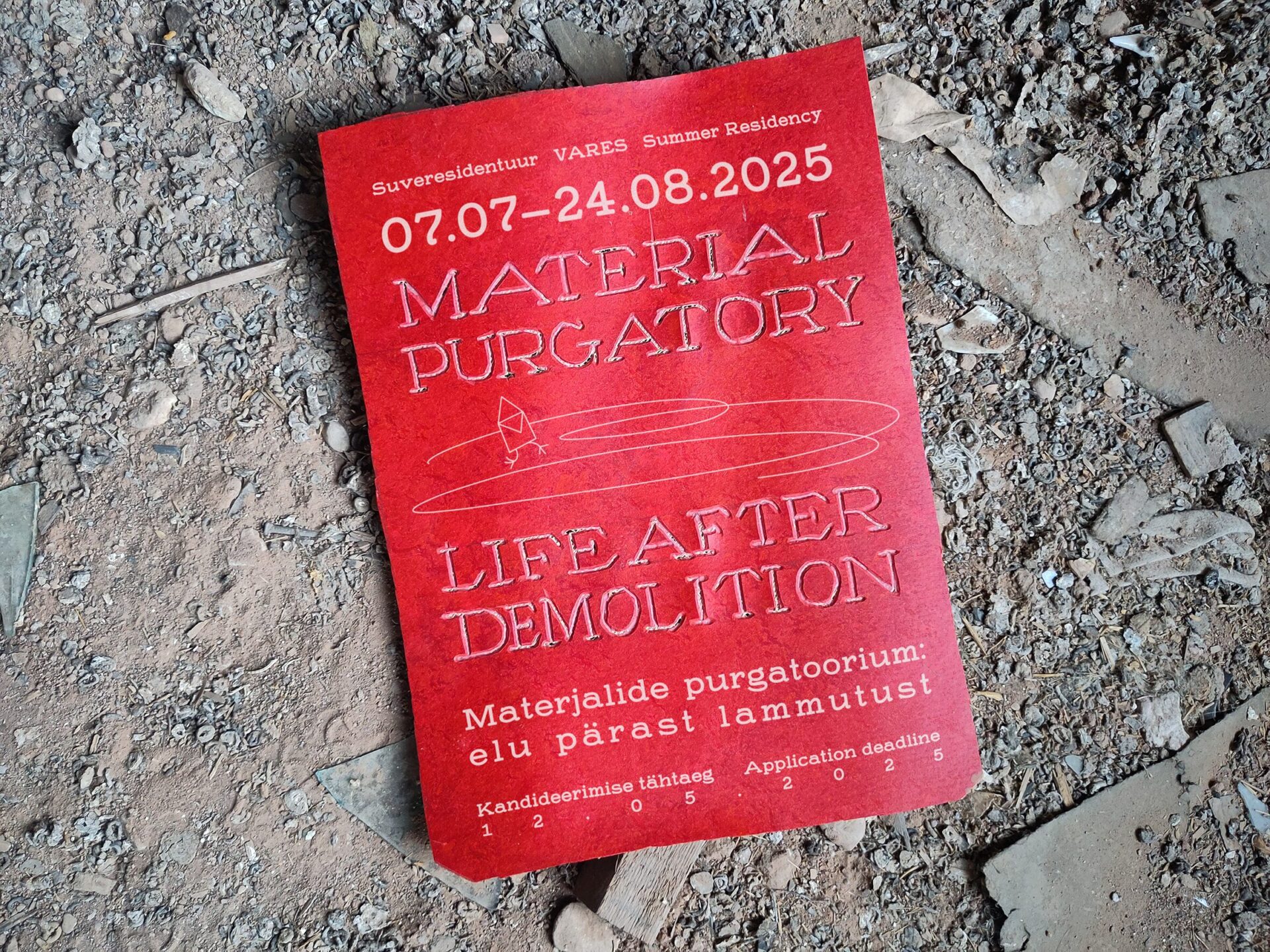Indrek Grigor: Your most recent short biographies all say something like ‘Tõnis Jürgens is a cinema projectionist and void enthusiast who is researching sleep as a possibility for resistance at the Doctoral School of the Estonian Academy of Arts.’
Let’s start with working as a cinema projectionist. You studied new media at the EAA, and your ongoing research and the present exhibition are about the digitisation of information. Based on this, I have to ask: why is your interest in film expressed through analogue media?
Tõnis Jürgens: I began my studies in the New Media Department at the Estonian Academy of Arts when Raul Keller had recently been appointed professor. Raul is a big fan of analogue, and under his guidance our studies were accompanied by a healthy scepticism about digital. We were studying elementary programming and the basics of electronics, while also looking back at the history of new media and sound art. I learned that new media art can also be made with very ‘low-tech’ means.
At the same time, I started working at the Sõprus cinema in Tallinn, where I was a projectionist for six or seven years. By that time, they already used mainly a digital projector, and 35mm film was, and still is, only projected on rare occasions.
That’s where I found that the arrival of actual rolls of film at a cinema, and everything associated with projecting it, carrying the heavy film canisters up and down the stairs, checking the copy, servicing the projector, and the excitement of the screening, is a very special event.
A reel of film inevitably bears the traces of all previous screenings and projectionists. The projectionist should, of course, remember that it should be handed over for future screenings in the same or even better condition, but the process of screening and transport inevitably leads to some wear and tear. In this sense, a copy of a film is a physical artefact which continues recording something new, even after the shooting, editing and recording of the final version has ended. This is definitely accompanied by a certain romanticism and nostalgia.
All digital media are also material, but we don’t usually see this physical aspect so clearly. It’s hidden in tiny electric schematics and darkened data centres, and floats above us in thousands of satellite constellations. I filmed Dreaming of Babylon on 16mm film with the idea of using the materiality of one medium to emphasise the materiality of the other. The choice was not motivated by the thought that a roll of film is something more authentic than digital video. Instead, I was thinking of this roll of film as an artefact that can be found in the future, as a peculiar document of a future time when there are no people on Earth, and only large black boxes roam the land.
I’m captivated by the idea of digital ruins. I’ve read a claim that after two months of storage, 80% to 90% of all the digital data stored every day is simply left unused, just sitting there. It’s interesting to ponder what will become of this data after a century has passed; for example, it may slowly rot away and be, in a sense, buried under grass.

Tõnis Jürgens’ exhibition ‘Dreaming of Babylon’, Tartu Art Museum, 2023. Photo: Paul Kuimet

Tõnis Jürgens’ exhibition ‘Dreaming of Babylon’, Tartu Art Museum, 2023. Photo: Paul Kuimet
IG: How did you end up researching sleep?
TJ: In my MA thesis on new media, I worked mainly with transhumanist philosophy. Its core idea, or at least hope, is that thanks to the development of technology, humanity will finally overcome all the woes and obstacles that hold us back, and maybe even overcome mortality itself. I associated transhumanism with the general history of cybernetics, the Hippie movement, the theories of Merleau-Ponty and McLuhan, and the rise of Silicon Valley. That thesis was maybe too muddled, and was guided by the idea of the disappearance of people into the machinery they have created.
Later, when I was applying to the Doctoral School at the Academy, I wanted to develop this topic in a more specific direction. The plan was to critically study wearable smart devices in the context of contemporary self-care. It seemed to me that there was an intriguing discrepancy there. According to the producers of wearables, today it is possible to measure very precisely a variety of biometric data: steps, pulse, temperature, brainwaves, the ability to concentrate, sleep patterns, and a whole lot more. The measuring of our daily data has actually been possible for centuries without resorting to digital means and using only good old paper and pencils. But thanks to smart devices, the ‘passive’ measurement data has also become possible, even when the user is not conscious, or when they are not actually present.
The theme of a missing subject was what fascinated me. Sleeping and dreaming seemed like a great metaphorical framework, which could be used to contemplate topics of self-surveillance and self-optimisation. When a person is sleeping, a machine is tracking them every second. And when the person wakes up, the smart device will tell them, based on the collected data, how well they slept. This is a vulnerable situation of sorts.
It’s about trust: we tend to prefer the machine and its seeming objectivity to our own perception. Tracking sleep with a smartwatch is in practice also less intrusive and costly than, for example, filming yourself sleeping from night to night and then reviewing the material. Therefore, we decide to trust the machine and its producer in the interest of convenience and apparent objectivity. However, smart devices do not collect data for our own private use only, but also send it to other parties, in the interest of general statistics and the development of the system.
The fact that our data is tracked and recorded in the digital world at every step has, of course, been old news for quite some time. But tracking sleep is interesting, because other types of data collection about our habits take place when we are at least seemingly in control. During sleep, however, we have temporarily disappeared from the world and are defenceless.
IG: For this exhibition, you made an artificial intelligence model generate descriptions of dreams which are based on the notes you have taken about your own dreams. Do you dream often? And where does the impulse to note them down come from?
TJ: I don’t dream, or I don’t recall my dreams, as often as I would like to. But for many years I have kept a dream diary next to my bed. I’ve accumulated a pile of these diaries. Years ago, the excitement of writing down dreams was more intense, and probably because of that I also recalled them in more detail. At first I did it as an exercise, to learn lucid dreaming, or the fine art of consciously controlling my dreams. I gave up trying to learn lucid dreaming quite quickly, but the habit of keeping a journal remained.
Writing down dreams is very similar to digitally measuring sleep patterns. Both are a form of self-tracking, but their emphasis is different. In the former, you yourself are the mediator and the unreliable narrator; while in the latter somebody or something else is narrating the story to you. Certain patterns inevitably emerge.

Tõnis Jürgens’ exhibition ‘Dreaming of Babylon’, Tartu Art Museum, 2023. Photo: Paul Kuimet
IG: In your articles, and, I presume, also in your research, you describe sleep as ‘an interruption of the capitalist theft of time, the only natural state in our lives which capitalism has not been able to occupy’. Are you interested in dreaming as a place of shelter, or in the continuous growth of big data and the possible complications these developments may entail, including the capitalisation of dreaming?
TJ: The idea of sleep as an interruption of the capitalist theft of time comes from Jonathan Crary’s book 24/7: Late Capitalism and the Ends of Sleep. According to him, all basic human needs, hunger, thirst, sex, a sense of belonging, have been commodified for a long time. Sleep, however, has (or at least had) been untouched, and has therefore represented a sort of last bastion of freedom not exploited by capitalism.
My research is based on the self-care industry and on the digital tracking of sleep: the voluntary subjugation of yourself to the machine. It could be said that measuring sleep directs more attention to correct sleeping habits. This, of course, is a very welcome development if a smart tracking device actually has such an influence. I have also heard similar positive opinions from people I know. But the seemingly benign intentions of the massive companies that produce smart devices also conceal shadier motives.
At the beginning of my doctoral studies, I acquired a Fitbit smartwatch as an experiment to better understand the digital measurement of sleep. The smartwatch works in tandem with a smartphone app, without which the device is essentially unusable. To run the application, I had to officially agree to the terms of use, which stated clearly and in large print that all the collected data would be sent to a data centre somewhere in North America, where Fitbit would use it at their own discretion.
It is quite feasible that Fitbit and other producers of sleep trackers sell the data collected with their devices to third parties. Since data is a commodity, the users of the devices who generate that data are working. The digital tracking of sleep therefore means that you are working while sleeping, free of charge. Coming back to the idea of sleep as ‘the last bastion of freedom’, we could say then that invaders have scaled the walls, or, more aptly, have stormed through an open gate: sleep is for sale. And if we take this metaphor for the materiality of data further, the data centres where our sleep data is gathered are like warehouses or logistics centres.

Tõnis Jürgens’ exhibition ‘Dreaming of Babylon’, Tartu Art Museum, 2023. Photo: Paul Kuimet

Tõnis Jürgens’ exhibition ‘Dreaming of Babylon’, Tartu Art Museum, 2023. Photo: Paul Kuimet
IG: The experiment that you did with artificial intelligence seems to show that you don’t forecast a bright future for sleeping? While the dystopian science fiction of the end of the 1960s asked ‘Do androids dream of electric sheep?’, should we now be considering the possibility that our dreams will become digitised (whatever that would mean)?
TJ: I would prefer not to comment on the brightness or darkness of our future. It seems that our current existing tech corporations have offered enough utopian visions for the future, and those in turn are balanced by the dystopian visions from pop culture, where humanity has been subjugated to machines, etc. So I don’t really have much to add to all these forecasts of the future. Or let’s just say that it seems wise not to offer any predictions. I am certain that the development of technology will make people think and act in new ways: in a sense, technology frames people’s imagination.
The famous media theoretician Marshall McLuhan interpreted various technologies as extensions of people’s minds and bodies. I’m paraphrasing here, but McLuhan predicted as early as the 1960s that thanks to electronic media, people’s nervous systems, and maybe even their thought processes, will be extended to the electricity grid. Today, when I can ask for advice from a language algorithm about what to have for dinner, which exercises are good for a primary school class to do in a history lesson, how to overcome everyday anxiety, or whatever else I need, and when the machine replies with answers and advice that feel completely natural and sensible, it seems to me that McLuhan’s predictions have indeed come true.
Communicating with ChatGPT, for example, means that you are participating in a massive sociological experiment. The OpenAI company, which developed this linguistic algorithm, has been completely frank about this. All the questions asked by the users and the replies generated by the algorithm are fed back into the system in order to keep developing it. It would be intriguing to know what people ‘secretly’ ask the algorithm, and what linguistic tricks or ethical questions they use to test the system. But the main point here is that this amounts to data harvesting on a massive scale, and dialogues with the machine are recorded in a physical manner as particles of data on a medium. This is perhaps a simplistic and even banal realisation, but I think it’s nevertheless important to keep in mind.
Speaking of dreams, maybe one of the most important questions this exhibition asks is what the digitisation of dreams could look like. There seems to be no definitive answer as to why people, and other beings as well, dream at all. In this context, the digitisation of dreams looks like an absurd investment in the unknown. It is the storage and archiving of data without having a clear understanding of, or a methodology for, its usage. At the same time, such an approach is quite characteristic of big data science, and science in general.

Tõnis Jürgens’ exhibition ‘Dreaming of Babylon’, Tartu Art Museum, 2023. Photo: Paul Kuimet
IG: The title of this exhibition is a literary one. Dreaming of Babylon is the title of Richard Brautigan’s 1977 novel, which mocks the detective noir genre, and has the subtitle A Private Eye Novel 1942. The exhibited video shows a lone server rack wandering about in a landscape, which seems devoid of, or at least abandoned by, humans. Due to the contrast between nature and technology, the box seems to be self-absorbed, caught in its own universe. It has delved into working with its own problems, which means that the title of Brautigan’s novel draws parallels with Jorge Luis Borges’s Library of Babel, which, according to the theme of your exhibition, could represent the dream that the server is seeing.
Please tell us more about the server before I start referring to a recent meme about monoliths and start looking for parallels with 2001: A Space Odyssey.
TJ: The connections with Brautigan’s novel are actually quite implicit and arbitrary. To answer this, I have to take a bit of a detour.
In the 1960s, Brautigan wrote a poem called ‘All Watched over by Machines of Loving Grace’, where he described, with romantic undertones, and it’s hard to understand if this is meant ironically or idealistically, the conjoined existence of machines and nature on a ‘cybernetic meadow’. The British visual essayist Adam Curtis later borrowed this title for one of his documentary series, which illustrates how theories of cybernetics and ecology became intertwined in the 1950s and 1960s, and how this in turn has influenced our current understanding of the relationship between machines and nature. This is the origin of the idea that nature is a self-organised and self-balancing system, that it is ruled by a harmony much like closed electric circuits. This point of view, as it became clear some time in the 1980s, is not completely true: nature and its ecosystems are more chaotic and unfathomable than we would like to believe. This documentary or video essay series by Curtis was a major inspiration for my MA thesis.
Some years later, my colleague and friend Erki from the Sõprus cinema gave me a novel by Richard Brautigan, Dreaming of Babylon. The book is a satire, as you said, a story about an unsuccessful private detective called C. Card, who lives in a small and dirty flat in an unnamed city in the United States in the 1940s, and who has trouble solving his cases. He has neither ammunition for his gun nor any ability to concentrate, because he is always getting lost in his dreams. He dreams about being a famous explorer, or an immensely successful detective in a film, or something else like that. In the book, and in Card’s mind, this place and the act of disappearing into one’s dreams are described as ‘dreaming of Babylon’. I don’t know why Brautigan chose the name of this ancient city as a basis for Card’s dreams: maybe to present a certain counterpoint between Card’s dissolving life and the glory and unattainability of Babylon.
A couple of years later, due to a discontinued film project, I managed to get my hands on some 16mm film stock and film equipment. I had toyed with the idea of photographing a server rack in nature, inspired by the themes of Adam Curtis’ series. Now it made sense to film it instead. And thanks to the help of many friends and other good people, the project became a reality. At some point, I wrote on the end of a reel of film ‘Dreaming of Babylon’ as a working title, because it seemed to fit. Afterwards, I started seeing other connections besides the ones in the Adam Curtis series, and so the title stuck.
Artistic research in general is characterised by a certain intuitive approach: first you do things, collect material, and hold an exhibition, and afterwards you develop a theory based on reflection. The meaning becomes apparent. Henk Borgdorff, an important theoretician of artistic research, has said that it is not based so much on hypothesis as on discovery.
Over the course of my PhD studies at the Estonian Academy of Arts, I’ve half-jokingly thought of myself as the paranoid neighbour, who sees one day, peeking through the blind on his window, that a crime or some suspicious activity is taking place in an apartment across the street. This idea had an especially strong impact during the pandemic and lockdown. It seems to me that artistic research is much like a private detective’s practice: you reach for every clue, follow your intuition, constantly get side-tracked, and eventually it might happen that one of these digressions becomes the main line of your research.
After a while, you might start seeing important patterns in various random formations. In psychology they use the term ‘apophenia’ to denote his: a very human tendency to see connections between random things. Therefore, I sense a personal connection between Brautigan’s half-sleeping private detective and myself as a doctoral student conducting artistic research.

Tõnis Jürgens’ exhibition ‘Dreaming of Babylon’, Tartu Art Museum, 2023. Photo: Paul Kuimet
IG: The gallery looks like a bedroom built in a film studio. I would like to ask bluntly: Why? Sleeping and a bedroom, I understand. And the stage aspect and ‘artificial dreams’, okay. But what about the film set? I could understand a green screen or a botanical garden, but why a film set?
TJ: One of the key terms or beacons to which I return again and time again is ‘illusion’. Film sets are used to create an illusion of something whole, using limited means and selected camera angles. In reality, it is only set design, a facade, a substitute, smoke and mirrors, which allow film makers to direct the attention of the viewers as they wish.
The psychoanalyst Jacques Lacan is famous for the theory that our unconscious is structured much like language, and the symbols of this language emerge in our dreams. According to him, dreams mediate certain primal and raw urges, which we would not dare to admit while awake. This notion of a linguistically structured unconscious, of course, has its connections with language algorithms. But with this exhibition, another function of dreams might be even more important, as noted by Steven Levine, who has written an interpretative summary of Lacan’s theories. According to him, dreams are like will-o’-the-wisps, ignis fatui: a sort of necessary illusion, which distracts the sleeper from the fact that in sleep they can very easily be observed by others, and are in that sense in a vulnerable situation.
In the context of digital sleep tracking, we can talk about other necessary illusions. The alleged precision of the data collected by wearable tracking devices is a necessary illusion for users measuring their sleep to feel as if they have control over things while they are sleeping, that they can optimise themselves even when they’re not conscious. This same seemingly progressive and benevolent illusion is applied by the self-care industry to conceal the fact that users’ data can be turned into commodities, that sleep can be a form of work.
Coming back to the film set as such, the fragile illusion of a film world can break apart at any moment when a boom microphone suddenly appears in the frame by mistake, or when we glimpse the cameraman unintentionally reflected in a shiny surface. We’re abruptly pulled out of the dream and projected into an artificial world. Actually, moments of recognition like this are also the basis of lucid dreaming or controlling your dreams: we learn how to recognise extraordinary elements in the ‘mundaneness’ of dreaming in order to differentiate dreams from wakefulness.
IG: You describe the atmosphere of a film set with the term unheimlich, or ‘uncanny’. Why do you want the visitor’s first reaction to be one of unease?
TJ: I think this sense of uncanny unease is something we’ve become used to. Linguistic and visual algorithms, deep fakes, virtual influencers and other kinds of technological developments are accompanied by a certain familiar feeling of replaceability, that an additional reality can be created using algorithms. As I mentioned before, elements of pop culture like The Matrix quadrology, Black Mirror, Terminator 2, Ghost in the Shell, Abre los ojos, They Live!, Kubrick’s 2001: A Space Odyssey and all the rest have played a very important role in creating this familiarity with the uncanny.
We can use unheimlich or ‘uncanny valley’ or ‘simulacrum’, or something else, to describe this feeling. The uneasy thing here might be the idea that our known reality can be increasingly and convincingly recreated by machines. This might mean that machines are capable of showing imagination at the same level as us. And if a language algorithm tells me, for example, that artificial intelligence could never emulate the human imagination, either now or in the future, this for some reason feels especially uneasy.
The American comic Steven Wright tells a great joke, which goes something like: ‘One morning I woke up and saw that all my things had been stolen and replaced by exact replicas. I called my roommate and told him what had happened. He looked at me wide-eyed, and said: “Do I know you?”’

Tõnis Jürgens’ exhibition ‘Dreaming of Babylon’, Tartu Art Museum, 2023. Photo: Paul Kuimet
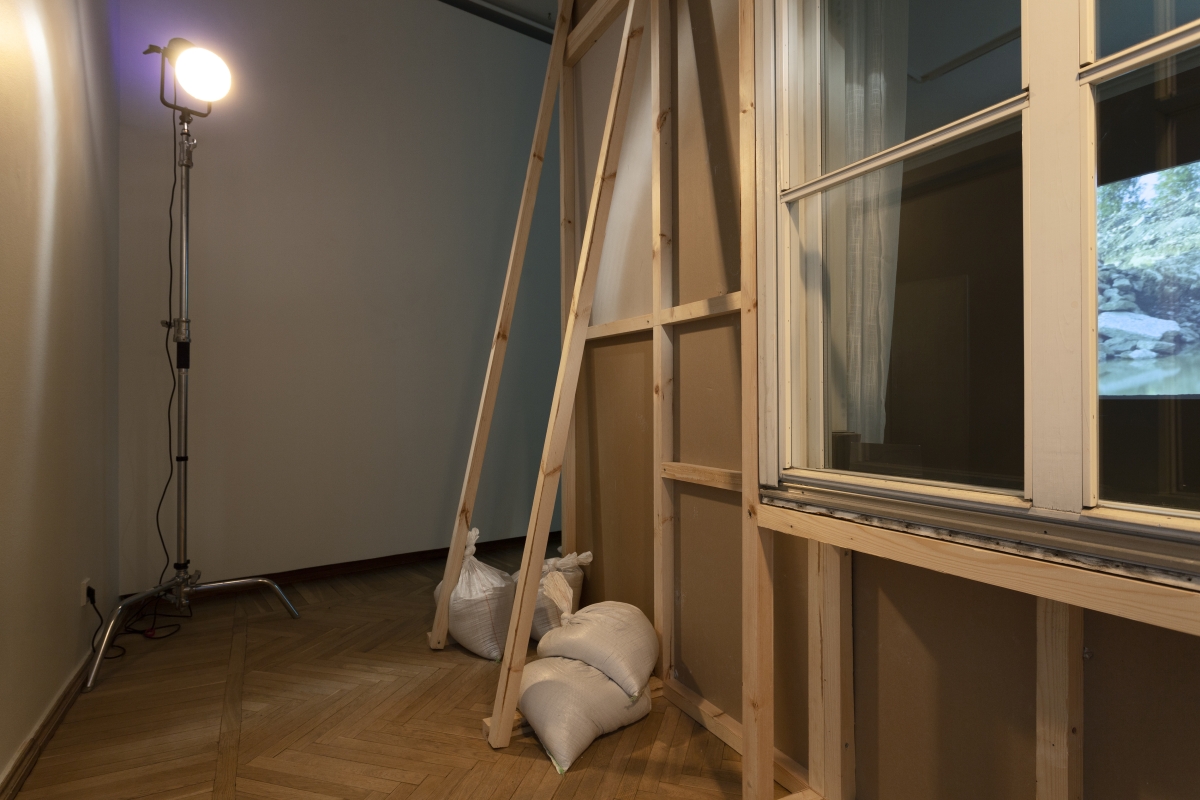
Tõnis Jürgens’ exhibition ‘Dreaming of Babylon’, Tartu Art Museum, 2023. Photo: Paul Kuimet

Tõnis Jürgens’ exhibition ‘Dreaming of Babylon’, Tartu Art Museum, 2023. Photo: Paul Kuimet

Tõnis Jürgens’ exhibition ‘Dreaming of Babylon’, Tartu Art Museum, 2023. Photo: Paul Kuimet
